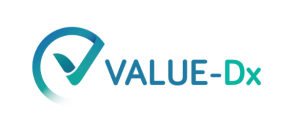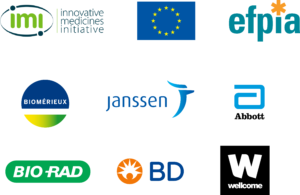Why would patients, doctors, health insurers and governments pay for tests that are six times more expensive than the accompanying treatment? That is the question that we try to unravel within VALUE-Dx. To take the Netherlands as an example, the reference price (excluding pharmacy fees) for a 3-day course amoxicillin is €0.69, while this is €4.07 for a C-reactive protein test. Clearly, just giving all patients an antibiotic is much cheaper than testing them and provide an antibiotic in case of a positive result. Core to VALUE-Dx is the reduction of therapeutically inappropriate antibiotic prescriptions and, related to that, antimicrobial resistance (AMR) on the long term. Hence, quantifying the societal costs of AMR is one of the main issues in our research. Another issue is more general, which is the economic appraisal of diagnostics. Compared to pharmaceuticals, methods for economic evaluations and rules for reimbursement are much less developed in this field.
Finding answers to above questions and solutions for improvement of underlying mechanisms requires an interdisciplinary approach: our work on Economic Value, Policies and Innovative Funding Models therefore integrates a variation of tasks and viewpoints, distributed over various organizations: academic institutions (with UMCG leading the WP), governmental agencies, and companies (with bioMérieux co-leading the WP). Although most groups are ongoing in the research process, we have already two milestones to celebrate. Firstly, NICE has established the Expert Advisory Panel (EAP), a group of 10 experts that will provide input on the appraisal process of diagnostics. Secondly, the University of La Rioja and the UMCG have finished the first deliverable of WP5: a systematic review of health-economic approaches for diagnostic-driven antibiotic use, in which best practises are discussed to develop health-economic models for VALUE-Dx. One of the findings of the review was that opportunities for economic models of infectious disease diagnostics, mainly lie in the inclusion of generic quality-of-life outcomes, as opposed to (disease-)specific outcomes, and in the inclusion of time in the analyses, mainly in assessing more extensive time horizons (over 10 years).
Below are updates on the progress of the different tasks:
Task 5.1 Establishment, maintenance and management of a WP5 regulatory-HTA-payer EAP (NICE; GÖG, UMCG, bioMérieux)
The organisation and structure for the EAP has been developed and set in place. Following successful recruitment, a first session in parallel with the Bologna meeting was being planned. However, due to the COVID-19 pandemic this has unfortunately been delayed. The first meeting is now expected in the autumn and will provide key advice and input into other tasks and across work packages.
Task 5.2: Review of the current HTA environment and methodologies, inclusive health-economic frameworks and models, used for valuing diagnostics and analysing antibiotic resistance (UNIRIOJA, UMCG; NICE, GÖG, bioMérieux)
The first version of the systematic review was finished in April. Currently, preparations are taking place to disseminate the findings in a scientific paper as well as to search for articles to be included in the 2021 update.
Task 5.3 Trial-based health-economic analysis of (rapid, localised) diagnostics strategies in close collaboration with WP4 (UNIRIOJA; UA, NICE, bioMérieux)
As the protocols of the clinical trials of WP4 are being finished, the team of task 5.3 (as well as the team of task 5.4) has been readily involved with making sure the right data are analysed in the trial to be able to perform rigorous economic evaluations as soon as the first results come in. The models used to perform the economic analyses of the diagnostic strategies are being prepared.
Task 5.4 Development of a health-economic model for cost-effectiveness of diagnostics beyond the trial-based setting (UMCG; OECD, NICE, UA, UMCU, bioMérieux, BD, Accelerate, Janssen)
The first year of VALUE-Dx was mainly a year to rethink, on a fundamental level, how to assess the broad, long-term public health and economic impact of implementing point-of-care diagnostics and how to model this. Now, the first prototype is being developed using data from demographic databases, scientific literature, and the point-prevalence survey of WP4.
Task 5.5 Analysis of existing and potential innovative policies applied to include new diagnostics in the care systems of European countries with a view of identifying good practice and a proposal for enhancing fit-for purpose policy frameworks related to HTA, pricing and funding mechanisms (GÖG; NICE, UMCG, UNIRIOJA, bioMérieux)
This task will gather very useful information on the funding policies for diagnostics within many European countries. Data from a literature search (which is being executed right now), will be used to populate a survey (currently almost finished) that will be sent out later this year. The survey will provide essential insight to be able to adapt the health-economic models to the various countries included in VALUE-Dx, as well as provide recommendations on how to improve funding mechanisms in Europe.
Task 5.6 Transferability of health-economic approaches and results of such transfers between countries, notably to H2020 Associated Countries (OECD; UNIRIOJA, BU, bioMérieux)
Task 5.6 translates the findings from the economic analyses (tasks 5.3 and 5.4) to countries outside the trial. The model used will be closely aligned with the model developed in task 5.4 and the OECD SPHeP-AMR model, which are both are under active development right now.
Task 5.7 Interviewing stakeholders on policy and regulatory factors (UOXF, UA; UNIRIOJA, GÖG)
This qualitative research project will provide valuable insights on the facilitators and barriers of adapting or implementing novel diagnostics in community care, by interviewing policy and decision makers of certain member states. Due to the COVID-19 crisis and subsequent changes to delivery of care in community care settings we are postponing interviews until policy makers have better availability, hopefully later this year or the beginning of next year. From an administrative viewpoint, everything is good to go.


